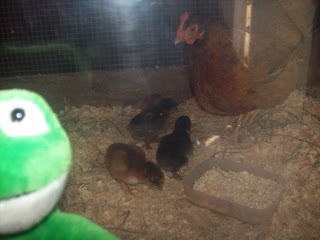A covalent bond is a force between two or more atoms that holds them together. The bond is provided by electrons that travel between the atom's nuclei, holding them together. In biology the covalent bonds are called strong bonds, because they are normally not broken under biological conditions unless an enzyme catalyst is present. There is a type of covalent bond called a polar covalent bond, which are important since these bonds allow the formation of another kind of weak bond called a hydrogen bond. Water is an example of a polar covalent bond, which is why I took a picture of this water bottle to represent the covalent bond.
Source:
Covalent Bonds (December 12, 2006). biology-online.org. Retrieved on August 31, 2011, from
http://www.biology-online.org/dictionary/Covalent_bonds
AP BIO
Wednesday, August 31, 2011
Model Organism
A model organism is a non-human species that is extensively studied to understand certain biological happenings, which they hope to make discoveries that will provide a better understanding of these special happenings. Model organisms are used to understand genetics, tissues, organs, stem-cells, and much more. Many model organisms are used to hopefully find cures or treatments for certain human or other organism's diseases. Many viruses, , prokaryotes, fungi, plants, protists, and animals are model organisms used for multiple fields of research. This is a picture of a chicken with its chicks, but chickens are one of the very important animal model organisms, since their eggs are studied very closely and are excellent for micro-manipulation (like skin grafting), as well as being great exemplary animals in genetic breading.
Source:
Teaching With Model Organism (n.d.) wormclassroom.org. Retrieved on August 31, 2011, from
http://www.wormclassroom.org/teaching-model-organisms
Invertebrates
Invertebrates are animals without backbones which includes about 97% of all animals except for mammals, reptiles, birds, amphibians, and fish. Scientist usually break down invertebrates into 8 major groups which are Arthropods (which include insects and arachnids), sponges, cnidarians (like jellyfish), annelid worms (like earthworms), flatworms (tapeworms), roundworms or nematodes, mollusks (shellfish and slugs or snails), echinoderms (like star fish). Invertebrates are heterotrophs since they must consume other organisms to survive. This picture is of an earthworms which are invertebrates since they have no back bones and are under the invertebrate category of annelid worms.
Source:
Invertebrates. (n.d.) edHelper.com. Retrieved on August 31, 2011, from
http://www.mysciencesite.com/invertebrates.pdf
Fungi
Fungi is a kingdom of very important organisms, in terms of ecological roles. This is because fungi break down dead organic material which continues the cycle of nutrients through ecosystems. Most vascular plants could not grow without the symbiotic fungi, which inhabit their roots and supply essential energy. Fungi can also cause a number of animal and plant diseases that are more chemically and genetically similar to animals and other organisms which makes them hard to treat. Plant diseases by fungi include rusts, smuts, and leaf, root, and stem rots, and may cause damage to crops. Fungi are not heterotrophs since they do not have chlorophyll, which is why they absorb nutrients into their hyphae. Most fungi live as multicellular filaments which is the hyphae. Fungi reproduce through spored which can be asexual or sexually produced spores. Examples of fungi are yeasts, rusts, stinkhorns, ringworm, molds, mildews, and mushrooms, which is why this picture has the frog sitting next to two mushrooms.
Source:
Fungi. (June 15, 2008). biology-online.org. Retrieved on August 31, 2011, from
http://www.biology-online.org/dictionary/Fungi
Q:What did the mushroom say after he got rejected for a date?
A: But I am a fungi!!!!!

Source:
Fungi. (June 15, 2008). biology-online.org. Retrieved on August 31, 2011, from
http://www.biology-online.org/dictionary/Fungi
Q:What did the mushroom say after he got rejected for a date?
A: But I am a fungi!!!!!

Sepal
Sepals are located at the base of the flower structure which forms the calyx of the flower. The sepals are meant to protect the lower bud. Sepals are usually green but may be actually be the same color as the plant. That is why if you look closely to this picture under the rose are the little green leave like things, but they are the sepals.
Source:
Sepal. (October 3, 2005). biology-online.org. Retrieved on August 31, 2011, from
http://www.biology-online.org/dictionary/Sepal
Stamen
A stamen is the male reproductive part of a flower that consists of pollen sac (anther) and a long supporting filament. This filament holds the anther in position, making the pollen available for it to be dispersed by the wind, insects, or birds. The pollen grains are produced here by meiosis which is required for an angiosperm plant to reproduce. This picture shows the stamens clearly if you look at the inside of the yellow flower which looks like little rods with a small head tip on it.
Source:
Stamen. (October 3, 2005). biology-online.org. Retrieved on August 31, 2011, from
http://www.biology-online.org/dictionary/Stamen
Aggregate Fruit
An aggregate fruit is a type of fruit that develops from a single flower of many pistils (ovaries). The flower is simple with one corolla, one calyx, and one stem, but has many pistils. Each is fertilized separately, so if one does not pollinate successfully then the fruit will be misshapen. Examples of aggregate fruit are strawberries and raspberries, which is why these pictures are of strawberries and raspberries.
Source:
Aggregate Fruit. (June 5, 2009). biology-online.org. Retrieved on August 31, 2011, from
http://www.biology-online.org/dictionary/Aggregate_fruit
Subscribe to:
Comments (Atom)







